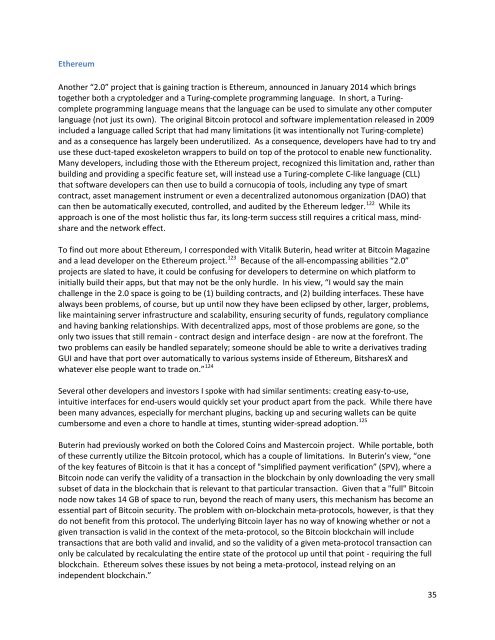Great+Chain+of+Numbers+A+Guide+to+Smart+Contracts,+Smart+Property+and+Trustless+Asset+Management+-+Tim+Swanson
Great+Chain+of+Numbers+A+Guide+to+Smart+Contracts,+Smart+Property+and+Trustless+Asset+Management+-+Tim+Swanson
Great+Chain+of+Numbers+A+Guide+to+Smart+Contracts,+Smart+Property+and+Trustless+Asset+Management+-+Tim+Swanson
You also want an ePaper? Increase the reach of your titles
YUMPU automatically turns print PDFs into web optimized ePapers that Google loves.
Ethereum<br />
Another “2.0” project that is gaining traction is Ethereum, announced in January 2014 which brings<br />
together both a cryptoledger and a Turing-complete programming language. In short, a Turingcomplete<br />
programming language means that the language can be used to simulate any other computer<br />
language (not just its own). The original Bitcoin protocol and software implementation released in 2009<br />
included a language called Script that had many limitations (it was intentionally not Turing-complete)<br />
and as a consequence has largely been underutilized. As a consequence, developers have had to try and<br />
use these duct-taped exoskeleton wrappers to build on top of the protocol to enable new functionality.<br />
Many developers, including those with the Ethereum project, recognized this limitation and, rather than<br />
building and providing a specific feature set, will instead use a Turing-complete C-like language (CLL)<br />
that software developers can then use to build a cornucopia of tools, including any type of smart<br />
contract, asset management instrument or even a decentralized autonomous organization (DAO) that<br />
can then be automatically executed, controlled, and audited by the Ethereum ledger. 122 While its<br />
approach is one of the most holistic thus far, its long-term success still requires a critical mass, mindshare<br />
and the network effect.<br />
To find out more about Ethereum, I corresponded with Vitalik Buterin, head writer at Bitcoin Magazine<br />
and a lead developer on the Ethereum project. 123 Because of the all-encompassing abilities “2.0”<br />
projects are slated to have, it could be confusing for developers to determine on which platform to<br />
initially build their apps, but that may not be the only hurdle. In his view, “I would say the main<br />
challenge in the 2.0 space is going to be (1) building contracts, and (2) building interfaces. These have<br />
always been problems, of course, but up until now they have been eclipsed by other, larger, problems,<br />
like maintaining server infrastructure and scalability, ensuring security of funds, regulatory compliance<br />
and having banking relationships. With decentralized apps, most of those problems are gone, so the<br />
only two issues that still remain - contract design and interface design - are now at the forefront. The<br />
two problems can easily be handled separately; someone should be able to write a derivatives trading<br />
GUI and have that port over automatically to various systems inside of Ethereum, BitsharesX and<br />
whatever else people want to trade on.” 124<br />
Several other developers and investors I spoke with had similar sentiments: creating easy-to-use,<br />
intuitive interfaces for end-users would quickly set your product apart from the pack. While there have<br />
been many advances, especially for merchant plugins, backing up and securing wallets can be quite<br />
cumbersome and even a chore to handle at times, stunting wider-spread adoption. 125<br />
Buterin had previously worked on both the Colored Coins and Mastercoin project. While portable, both<br />
of these currently utilize the Bitcoin protocol, which has a couple of limitations. In Buterin’s view, “one<br />
of the key features of Bitcoin is that it has a concept of "simplified payment verification” (SPV), where a<br />
Bitcoin node can verify the validity of a transaction in the blockchain by only downloading the very small<br />
subset of data in the blockchain that is relevant to that particular transaction. Given that a "full" Bitcoin<br />
node now takes 14 GB of space to run, beyond the reach of many users, this mechanism has become an<br />
essential part of Bitcoin security. The problem with on-blockchain meta-protocols, however, is that they<br />
do not benefit from this protocol. The underlying Bitcoin layer has no way of knowing whether or not a<br />
given transaction is valid in the context of the meta-protocol, so the Bitcoin blockchain will include<br />
transactions that are both valid and invalid, and so the validity of a given meta-protocol transaction can<br />
only be calculated by recalculating the entire state of the protocol up until that point - requiring the full<br />
blockchain. Ethereum solves these issues by not being a meta-protocol, instead relying on an<br />
independent blockchain.”<br />
35


